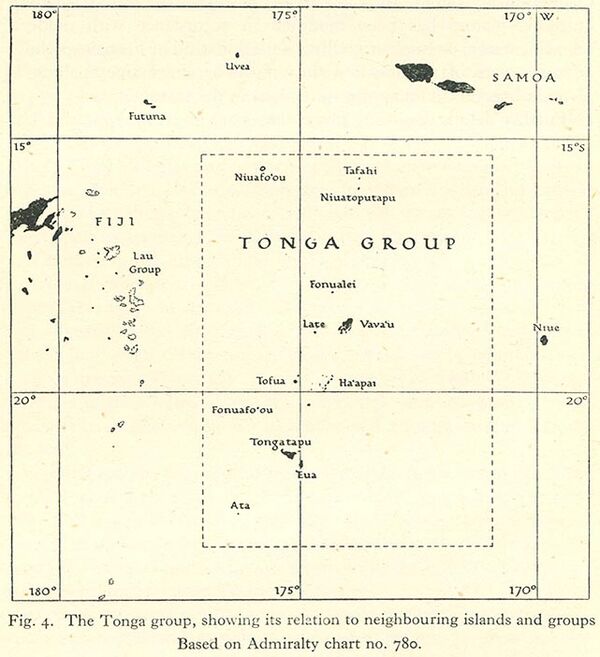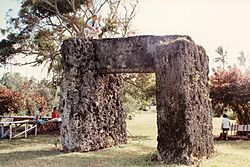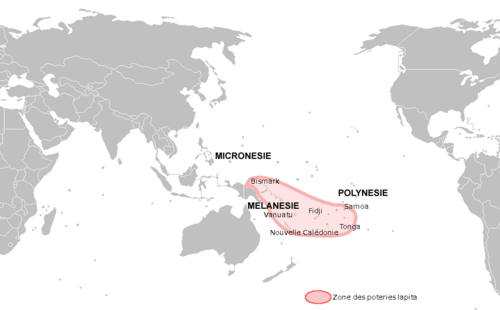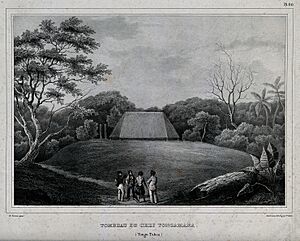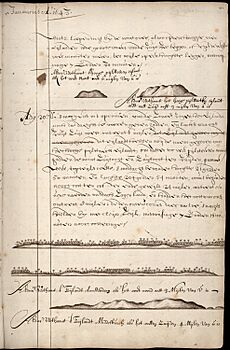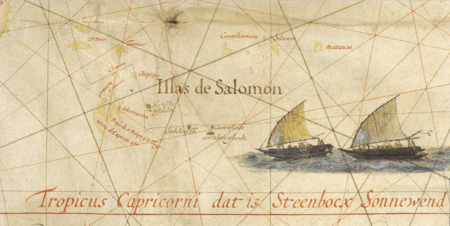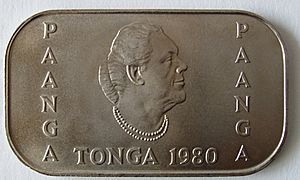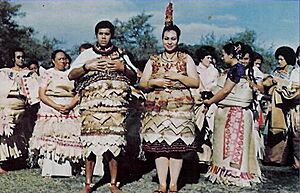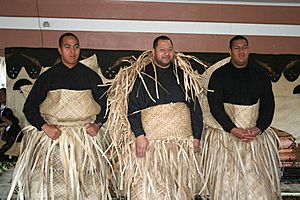History of Tonga facts for kids
The history of Tonga began a very long time ago, around 900 BC. This is when the first seafarers, known as the Lapita people, arrived and settled on these islands. Tonga, along with Fiji and Samoa, was like a doorway to the rest of the Pacific region called Polynesia. Old Tongan stories say that the islands of 'Ata and Tongatapu were pulled up from the deep ocean by the god Maui.
Contents
Early Times in Tonga
Scientists are still debating the exact dates when people first settled in Tonga. However, one of the oldest places where people lived is in the village of Pea on Tongatapu. Shells found there suggest people were living there about 3,180 years ago. The first signs of the Lapita people, like their pottery, were also found on Tongatapu. It was amazing how the Lapita people reached these islands without modern navigation tools! We don't know much about Tonga before Europeans arrived because there was no writing system. Instead, stories were passed down by word of mouth. The first Europeans to meet Tongans were Jacob Le Maire and Willem Schouten in April 1616. They made a short visit to trade.
Ancient Buildings and Stories
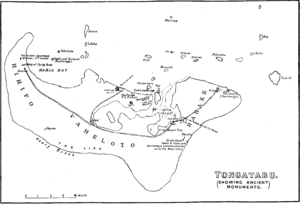
Hundreds of years before Europeans came, Tongans built huge stone structures. The most famous ones are the Haʻamonga ʻa Maui and the Langi terraced tombs. The Haʻamonga is 5 meters (about 16 feet) tall and made of three massive coral stones, each weighing over 40 tons! The Langi are low, flat pyramids with two or three levels. They mark the burial places of ancient kings.
Most of what we know about early Tonga comes from myths, songs, and poems, as well as from digging up old sites. Many ancient kitchens and rubbish heaps have been found on Tongatapu and Haʻapai. A few have also been found in Vavaʻu and the Niuas. These sites tell us about how people lived, what they ate, and their culture.
Life in Old Haʻapai
Three thousand years ago, the Haʻapai islands were different from today. Large birds that couldn't fly, called megapodes, roamed the rainforests. Giant iguanas and other lizards rested on tree branches. The skies were filled with different kinds of fruit bats, pigeons, and many other birds. There were no pigs, horses, dogs, cows, or rats back then.
The South Pacific was mostly empty of people. Then, a new group of people arrived from the Bismarck Archipelago near Papua New Guinea. They bravely traveled through the region, quickly settling new islands and moving east. They brought new plants and animals, and a special pottery style. Today, these people are called the Lapita, named after a place in New Caledonia where their pottery was first found.
The Lapita People Arrive
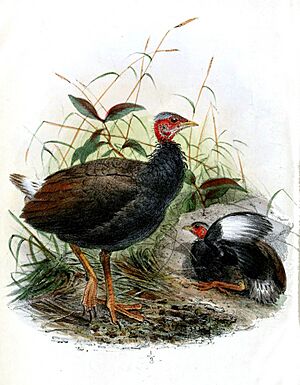
Around 3,000 years ago, the Lapita people reached Tonga. Carbon dating shows they landed first on Tongatapu and then on Haʻapai soon after. These newcomers were good at living on islands with limited resources. They settled in small groups of a few families on beaches, just above the high tide line, facing open lagoons or reefs.
They kept in touch with their Lapita relatives to the west and got domesticated animals and plants for farming. However, for the first two hundred years, they mostly ate seafood. They caught parrotfish, wrasses, turtles, surgeonfish, jacks, eels, emperors, and shellfish. They also caught deep-sea tuna. Just like their Polynesian descendants do today, they relied on the ocean.
While seafood seemed endless, animal life on land suffered. Soon, the giant iguanas, the megapodes, 24 bird species, almost all pigeons, and all but one type of fruit bat became extinct.
The Lapita people used simple tools. When shell pieces were too weak, they used volcanic rocks for tools like adzes (a type of axe), hammerstones, and cooking stones. If they were lucky, they found hard obsidian shards from the volcano of Tafahi in the Niuas.
Their special pottery had "dentate" (tooth-like) impressions and simple designs. Tongan Lapita designs were simpler than those from further west. They changed from fancy curved patterns to simple straight lines. The pottery was made from clay mixed with sand and fired at a low temperature.
Archaeological digs have taught us a lot about early Tongan settlements. We know what they ate, what tools they used, and where they settled. However, two big mysteries remain: How did they spread so quickly across the South Pacific? And why did they stop decorating their pottery so suddenly?
The Lapita people started their journey from Papua New Guinea around 1500 BC. By 900 BC, they were already in Tonga. This means they traveled east incredibly fast for 300 years. They sailed in small wooden boats across the open ocean to places they couldn't even see. Archaeologists wonder what made them go on such dangerous journeys. It doesn't seem like too many people were the problem, as most Lapita islands could have held more people.
One idea is that Lapita culture encouraged younger sons to explore. In Tonga, and throughout the South Pacific, land was often passed down to the eldest son. To get their own land, younger sons had to explore. Tangaloa, the main Tongan god before Christianity, was a younger brother who created Tonga while looking for land from his canoe. His fish hook accidentally caught a rock on the ocean floor, and he pulled Tonga to the surface.
The other mystery is why the fancy pottery designs disappeared so quickly. Only 200 years after arriving, Lapita settlers stopped decorating their pots. Scientists aren't sure why. Some guess they started using coconut cups, or changed their cooking methods, or that Tongan clays weren't good for pottery. We only know for sure that the same thing happened in Fiji and Samoa.
The Polynesian Plain Ware Period: 700 BC – 400 AD
Life in Haʻapai changed a lot when the fancy pottery was replaced by simple, useful pots. Around this time, the people can be called Polynesian. All the people in the Polynesian triangle (New Zealand, Hawai’i, and Easter Island) can trace their family lines back to a few original settlers in Tonga.
These early Polynesians in Tonga started to rely more on farming and raising animals, and less on just seafood. Taro, yam, breadfruit, and banana became their main food sources. Domesticated animals became a bigger part of their diet. At old Lapita sites, only 24% of bird bones were from chickens. After the Polynesian change, this increased to 81%, showing they relied more on chickens and that other bird species might have disappeared.
More food meant the population grew a lot. A small Lapita "hamlet" grew into a village over a kilometer long. Settlements spread around the lagoon in Tongatapu, and villages finally reached the middle of the main island. Similar growth happened in the Niuas and Vava’u.
These early Polynesians also present a mystery to archaeologists. By 400 AD, they stopped making pottery altogether. They seemed to use more natural materials instead. This period is sometimes called a "dark age" because there's less archaeological information until powerful chiefdoms appeared hundreds of years later. People guess that they might have used coconut cups, or started baking food in underground ovens instead of steaming it in pots. It's also possible that Tongan clays weren't good for pottery. No one knows for sure, but the same thing happened in Fiji and Samoa.
The Formative Dark Age: 400–1200 AD
We don't know much about this time because there isn't much archaeological evidence. However, we do know that the population kept growing, reaching between 17,000 and 25,000 people on Tongatapu. Powerful chiefs started to appear to protect against the growing competition for resources. Tongatapu might have been united under one leader from the future Tuʻi Tonga family line. Old stories trace the king's family back through 39 people, possibly starting as early as 950 AD. However, the famous maritime empire didn't begin until after 1200 AD.
The Tongan Maritime Empire

By the 12th century, Tongans and their kings, called the Tu'i Tonga, were well-known across the Pacific, from Niue and Samoa to Tikopia. They influenced these islands for over 400 years. Some historians call this a "Tongan Empire," but it was more like a network of interacting sailors, chiefs, and adventurers. It's not clear if chiefs from other islands regularly visited Tonga to show their loyalty. Unique pottery and Tapa cloth designs also show that Tongans traveled to Fiji and Hawaii.
Around 950 AD, Tu'i Tonga 'Aho'eitu began to expand his rule outside of Tonga. Tongan and Samoan stories say that the first Tu'i Tonga was the son of their god Tangaloa. By the time of the 10th Tu’i Tonga, Momo, and his son, ‘Tu’itatui, the empire had spread from Tikopia in the west to Niue in the east. Their area included Wallis and Futuna, Tokelau, Tuvalu, Rotuma, Nauru, parts of Fiji, parts of the Solomon Islands, Kiribati, Niue, and parts of Samoa. However, some Polynesian islands like parts of Tahiti Nui, the Cook Islands, and the Marquesas were left alone. To rule such a large area better, the Tu’i Tongas moved their main seat of power to Lapaha, Tongatapu, near the lagoon. The Tu’i Tonga's influence was famous throughout the Pacific, and many neighboring islands traded resources and new ideas with them.
Under the 10th Tuʻi Tonga, Momo, and his son Tuʻitātui (the 11th Tuʻi Tonga), the empire was at its largest. Tributes for the Tu'i Tonga were collected from all the islands they controlled. This tribute was called the " 'Inasi " and happened every year in Mu'a after the harvest. All countries under the Tu'i Tonga had to bring a gift for the gods, who were represented by the Tu'i Tonga. Captain Cook saw an Inasi ceremony in 1777. He noticed many foreigners in Tonga, especially darker-skinned people from Fiji, the Solomon Islands, and Vanuatu.
The success of the Empire was largely due to its strong navy. The most common ships were long double-canoes with triangular sails. The largest Tongan canoes, called kalia, could carry up to 100 men. Famous ones included the Tongafuesia and the Lomipeau. These large ships helped Tonga become wealthy through trade and tributes flowing into the royal treasury.
The Tuʻi Tonga's power began to decline because of many wars and internal problems. In the 13th or 14th century, Samoa defeated Tu'i Tonga Talakaifaiki, led by the Malietoa family. To help manage the empire, a group of political advisors called the falefā was created. These officials initially helped keep control over other islands, but growing unhappiness led to the assassination of several rulers. In 1535 AD, Takalaua was killed by two foreigners while swimming in the lagoon of Mu'a. His successor, Kauʻulufonua I, chased the killers all the way to ʻUvea and killed them.
Because of so many assassination attempts, Kauʻulufonua created a new ruling family called Tu'i Ha'atakalaua, named after his father. He gave his brother Mo’ungamotu’a this new title. This new family was in charge of the daily decisions of the empire. The Tu’i Tonga remained the nation's spiritual leader, but still had the final say in important matters. During this time, the Tu'i Tonga "empire" became more Samoan in its ways, as the Tu'i Tonga kings themselves married Samoan women and sometimes lived in Samoa.
In 1610, the 6th Tu’i Ha’a Takalaua, Mo'ungatonga, created another important position called Tu’i Kanokupolu for his half-Samoan son, Ngata. This divided the rule even further. Over time, the Tu’i Kanokupolu's power grew and became more important in Tonga. This Tu'i Kanokupolu family brought many Samoan customs and titles to Tonga. According to Tongan scholars, this Samoan-influenced way of government and customs continues in modern Tonga today.
The first Europeans arrived in 1616, when Dutch explorers Willem Schouten and Jacob Le Maire saw Tongans in a canoe near Niuatoputapu. Then, Abel Tasman sailed past the islands on January 20, 1643. These visits were short and didn't change the islands much. Captain James Cook later visited Tonga in 1773, 1774, and 1777, and wrote about the Tuʻi Tonga kings.
Modern studies of archaeology, anthropology, and language confirm that Tongan culture spread widely. It influenced places like East ʻUvea, Rotuma, Futuna, Samoa, Niue, parts of Micronesia (Kiribati, Pohnpei), Vanuatu, and New Caledonia. While some experts prefer to call it a "maritime chiefdom," others argue that "empire" is still a good term, even if it was different from other empires.
Europeans Arrive and Christianity Spreads
In the 15th and 17th centuries, civil wars broke out in Tonga. It was during this time that the first Europeans arrived. Dutch explorers Willem Schouten and Jacob Le Maire visited the northern Tongan islands of "Cocos Island" (Tafahi) and "Traitors Island" (Niuatoputapu) from April 21 to 23, 1616. The kings of these islands came aboard their ships. Le Maire even wrote down a list of words from Niuatoputapu, a language that no longer exists. On April 24, 1616, they tried to land at "Island of Good Hope" (Niuafo'ou), but the people there were not welcoming, so they sailed on.
On January 21, 1643, the Dutch explorer Abel Tasman was the first European to visit the main island of Tongatapu and Haʻapai. He was looking for a faster route to Chile after sailing around Australia and New Zealand. He mapped several islands. Tasman named Tongatapu t’ Eijlandt Amsterdam (Amsterdam Island) because it had so many supplies. This name is only used by historians now.
The most important visits were by Captain Cook in 1773, 1774, and 1777. After him, the first London missionaries arrived in 1797, followed by the Wesleyan Methodist Walter Lawry in 1822. Around that time, most Tongans quickly converted to the Wesleyan (Methodist) or Catholic faiths. Other religions followed, including Pentecostals, Mormons, Seventh-day Adventists, and more recently the Bahá'í faith.
The islands were also visited by Spanish explorers Francisco Antonio Mourelle in 1781 and Alessandro Malaspina in 1793. Malaspina tried to claim Vavau for Spain but failed. French explorers also visited, including Marc-Joseph Marion du Fresne in 1772, Jean-François de Galaup, comte de Lapérouse in 1787, and Antoine Bruni d'Entrecasteaux in 1793. Fletcher Christian also led the famous mutiny on the Bounty in Tongan waters in 1789.
Tonga Becomes One Kingdom

In 1799, the 14th Tuʻi Kanokupolu, Tukuʻaho, was killed. This started a civil war in Tonga that lasted for 50 years. Finally, in 1845, a clever young warrior named Tāufaʻāhau united the islands into one Polynesian kingdom. He held the important title of Tu'i Kanokupolu, and he was baptized with the name King George Tupou I.
In 1875, with the help of a missionary named Shirley Baker, King George Tupou I declared Tonga a constitutional monarchy. This meant the king would share power with a government and follow a constitution. He freed the serfs (people who were tied to the land), created a set of laws, established land ownership rules, and allowed freedom of the press. He also limited the power of the chiefs. The islands were fully mapped by British warships in 1898.
-
King George Tupou I of the Friendly Islands, 1852.
-
Nukuʻalofa in 1887.
Tonga in the 20th Century

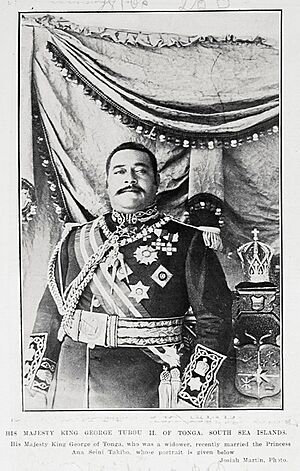
Tonga as a Protected State (1900–1970)
On May 18, 1900, Tonga became a British protected state under a special agreement called a Treaty of Friendship. This happened because European settlers and rival Tongan chiefs were trying to remove the second king, George Tupou II. The United Kingdom then handled Tonga's foreign affairs and had some control over its money.
The Treaty of Friendship and protected state status ended in 1970. This was planned by the third monarch, Queen Sālote, before she passed away.
Tonga was affected by the 1918 flu pandemic. About 1,800 Tongans died, which was about eight percent of the population.
For most of the 20th century, Tonga was peaceful and somewhat separate from the rest of the world. Tonga has a special social structure with three main groups: the king, the nobles, and the commoners. Between the nobles and commoners are Matapule, who are like "talking chiefs." They work with the king or a noble and might own land. Everyone has duties to each other. Nobles can ask for favors from people on their land, but they also have to help their people. Social status is very important in relationships, even within families.
-
King George Tupou II going to the Opening of Tongan Parliament in 1900.
Tonga During World War II
When the United Kingdom declared war on Germany in 1939, Tonga also declared war. Queen Sālote brought back the national army and gave 160 acres of land to the British to build an airfield. The people of Tonga raised enough money to buy three Spitfire planes for the British Royal Air Force. In August 1941, Queen Sālote called for a national day of prayer to support the British war effort.
In mid-1941, the New Zealand Army sent 70 military advisors to Nuku'alofa to train the Tongan Defence Force. After the attack on Pearl Harbor in December 1941, Tonga also declared war on Japan. People were moved out of Nuku'alofa, and barbed wire and trenches were put up on the beaches of Tongatapu, in case of a Japanese invasion.
Tonga Gains Independence (1970)
On June 4, 1970, Tonga's status as a protected state ended. This was part of the plans made by Queen Sālote before her death in 1965.
Tonga joined the Commonwealth of Nations in 1970 and the United Nations in 1999. Even though Tonga was influenced by colonial powers, it never lost its own government. This makes Tonga special in the Pacific and gives people confidence in its monarchy. The British High Commission in Tonga closed in March 2006.
Tonga's current king, Tupou VI, is directly related to six generations of past monarchs. The previous king, George Tupou V, born in 1946, had full control of the government until August 2008. At that point, because of concerns about money problems and calls for more democracy, he gave up most of his daily power over the government.
Tongans are now thinking about how to keep their culture and traditions alive as Western technology and culture become more common. People moving away from their villages and the growing use of money have changed the traditional extended family system. Some poor people, who used to be supported by their extended families, are now struggling.
Young commoners have more chances for education, and their growing political awareness has led to some disagreement with the noble system. Also, the population is growing very fast. There isn't enough land for every male at age 16, as required by the constitution. In 1982, there were 134 people per square kilometer. Because of these reasons, many people are moving to the only big city, Nukuʻalofa.
Tonga in the 21st Century
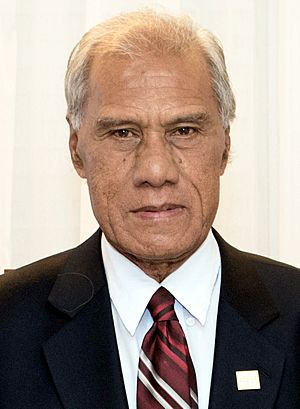
The 2002 Election
In the March 2002 election, supporters of the Human Rights and Democracy Movement (HRDM) won seven of the nine seats that people could vote for. The other two seats went to people who supported traditional values. About 48.9% of voters participated. The nine nobles and all the cabinet ministers in the Legislative Assembly usually supported the government.
After the election, HRDM leader 'Akilisi Pohiva was arrested. He was accused of sedition (trying to cause people to rebel against the government) because of an article in his newspaper Kele’a that claimed the king had a secret fortune. However, a jury later found him not guilty.
In 2003, the Taimi ʻo Tonga (Tongan Times), a newspaper published in New Zealand in the Tongan language, was stopped from being distributed in Tonga. The government didn't like its political content. After the newspaper got two court orders, it was allowed to be distributed again. A new law, the Media Operators Bill, and a change to the constitution were debated in 2003. These were meant to limit media freedom in Tonga. The new laws would let the government control what was reported on "cultural" and "moral" issues, ban publications it didn't like, and stop foreigners from owning media companies. In October 2003, thousands of Tongans marched peacefully in the capital city Nukuʻalofa. This was a rare protest against the government's plans to limit media freedom. Despite the protests, the bill and constitutional change passed the Legislature. By December 2003, they only needed the King's signature to become law.
By February 2004, the law was passed, and news media needed a license to operate. Newspapers like the Taimi ʻo Tonga, the Kele'a, and the Matangi Tonga were denied licenses. Only church-based or pro-government papers were allowed licenses. People continued to oppose the government's actions. The Tu'i Pelehake (a prince and elected member of parliament) asked Australia and other countries to pressure the Tongan government to make the election system more democratic. A legal request was also made for a court investigation of the bill. About 160 people supported this, including 7 of the 9 elected "People's Representatives."
The 2005 Election
In the 2005 Tongan general election, the Human Rights and Democracy Movement won seven of the nine seats that people could vote for. The other 30 members of parliament are chosen by the King or are members of the Tongan noble families. 'Aho'eitu 'Unuaki'otonga Tuku'aho, the King's son, was initially the Prime Minister. But he resigned in 2006 after the Speaker of the House was found guilty of bribery. The position then went to Feleti Sevele, who was the Minister of Labour. He was one of the two independent candidates elected and the first Prime Minister who was not a noble since the 19th century.
In 2005, the government spent several weeks talking with striking civil service workers before reaching an agreement. A group met in 2005–2006 to suggest changes to the constitution. A copy of their report was given to King Taufa'ahau Tupou IV shortly before he passed away in September 2006.
The 2006 Riots
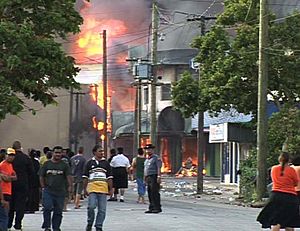
Tonga was not considered a "democracy" by the Freedom House report in 2006. This was because even though elections were held, people could only elect nine out of 30 seats in the Legislative Assembly. The rest were chosen by nobles or the government. So, people had a voice but not full control over the government.
The public expected democratic changes from the new king. On November 16, 2006, riots broke out in the capital city of Nukuʻalofa. This happened because it seemed that parliament would end its session for the year without making any progress on increasing democracy. Government buildings, offices, and shops were looted and burned. Eight people died in the riots. The government agreed that elections would be held in 2008, where most of the parliament would be elected by popular vote. A state of emergency was declared on November 17, giving security forces the right to stop and search people without a warrant.
On January 18, 2007, Pōhiva was arrested and accused of sedition for his role in the 2006 Nuku'alofa riots.
The 2008 Election
The April 2008 elections saw 48% of people vote to elect the nobles' representatives and the 9 people's representatives. Most of the pro-democracy members of parliament were re-elected, even though several faced charges of sedition related to the 2006 Nuku'alofa riots. All nine elected MPs were pro-democracy activists.
About two weeks before the election, it was announced that the Tonga Broadcasting Commission would censor political broadcasts from candidates. Also, TBC reporters were banned from reporting on political matters. Tonga Review criticized this decision, saying it limited freedom of speech. On May 29, 2008, Princess Regent Salote Mafile'o Pilolevu Tuita announced that the government would introduce a political reform bill by June 2008. She also said that the current term of Parliament would be the last one under the old constitution.
In July 2008, three days before his coronation, King George Tupou V announced that he would give up most of his power. He said he would follow his Prime Minister's advice on most matters after the upcoming elections.
In November 2009, a group reviewing the constitution suggested that the monarchy should be mostly ceremonial, without real political power. They recommended giving political power to a fully elected Legislative Assembly of Tonga (the Fale Alea). Up to this point, most seats in the assembly were passed down through noble families. These changes were part of a plan for constitutional reform.
Democracy and the 2010 Elections
In April 2010, the Legislative Assembly passed a set of political reforms to move towards a fully representative democracy. The number of directly elected people's representatives increased from 9 to 17. Ten seats were for Tongatapu, three for Vavaʻu, two for Haʻapai, and one each for Niuas and ʻEua. All these seats were for single areas, unlike the previous system where one area could have multiple representatives. These changes meant that 17 out of 26 representatives (65.4%) would be directly elected, up from 9 out of 30 (30.0%). The noble families would still choose their nine representatives, but all other seats, which were previously appointed by the king, would be removed.
Early general elections under the new law were held on November 25, 2010. The Taimi Media Network called the 2010 Tongan Legislative Assembly "Tonga’s first democratically elected Parliament." The Democratic Party of the Friendly Islands (DPFI), started in September 2010 to fight the election, won the most seats. Led by the experienced pro-democracy campaigner 'Akilisi Pohiva, they secured 12 out of the 17 "people's representative" seats.
ʻAkilisi Pohiva, the MP for Tongatapu 1, wanted to become Prime Minister. However, the nobles and independent MPs chose Lord Tuʻivakanō to form a government. This made the DPFI the main parliamentary opposition party. The DPFI proposed new laws for more democracy, including directly electing the Prime Minister from among the 26 elected MPs, and allowing all 26 MPs to be elected by popular vote. However, these ideas were not supported by the conservative majority.
When King George Tupou V passed away on March 18, 2012, his son ʻAhoʻeitu ʻUnuakiʻotonga Tukuʻaho became King of Tonga, taking the name ʻAhoʻeitu Tupou VI.
New elections in 2014 saw the DPFI lose three seats to independent candidates. Despite this, their leader Pohiva was still chosen as the new Prime Minister of Tonga. On August 25, 2017, Pohiva and the rest of parliament were dismissed by the King. New elections were held on November 16. The DPFI won 14 seats, enough for Pohiva to form a government without needing support from nobles or independent MPs.
The 2022 Tsunami
On January 15, 2022, a tsunami caused by a volcanic eruption swept through many parts of Tonga. The volcano, called Hunga Tonga–Hunga Haʻapai, caused waves that also put many places in Australia and other countries on high alert. Sadly, at least two people died in Peru because of this event.
See also
 In Spanish: Historia de Tonga para niños
In Spanish: Historia de Tonga para niños


